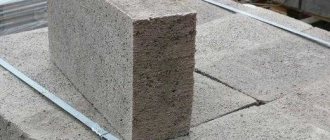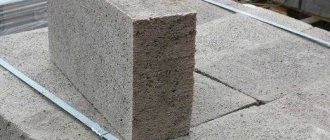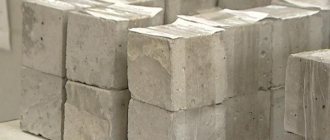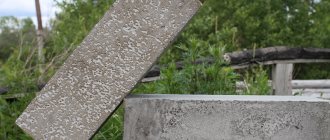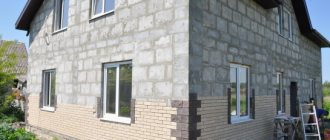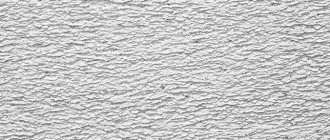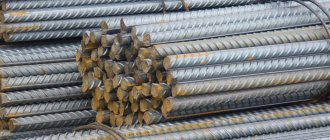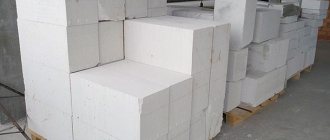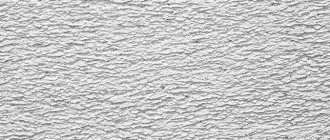A huge number of building materials allows any buyer to purchase something specific, more suitable for a particular case. Sand concrete blocks are especially popular in the construction of private houses and other structures. Like other materials, they have their own advantages and disadvantages. The choice of sand concrete blocks is made taking into account the nuances of construction work and future operation of the facility, and the availability of available funds.
Production and Application
Sand block is made from sand-cement mortar: high-quality cement, quartz sand and water. All components of the sand block are placed in special vibrating molds, after which they are subjected to semi-dry pressing. The next stage is thermal or infrared drying of these forms, in a room with a given temperature and constant ventilation for 28 days. Thanks to this production technology, the block has high physical and mechanical properties. Good technical characteristics of the material allow it to be used for the construction of the following objects:
- garage;
- stock;
- cellar;
- fence;
- household and economic buildings;
- interior partitions;
- construction of the foundation.
It should be noted that using a sand block as a foundation allows you to save on the rental of specialized equipment, since the weight of 1 piece of sand block does not exceed 30 kg.
Prefabricated column foundation
For buildings such as a one-story wooden house, a bathhouse, etc., a prefabricated strip foundation, even one erected independently from small-sized blocks, is often excessive - both in terms of its load-bearing capabilities and in terms of the effort and resources spent on it. You can save on excavation work, building and insulating materials and at the same time provide a reliable foundation for your house by building a columnar foundation from the same blocks.
Based on data on the composition of the soil at the site, the level of groundwater and expected loads, specialists calculate the depth of the supports and their cross-sectional size.
As a rule, the pillars are made recessed or shallow, and the difference between them is expressed only in the number of rows of blocks. The main thing is that they rise above the ground by at least 40 cm. If the area is flooded, has a very pronounced relief, or the height of the snow cover in a given region is significantly greater than this value, the supports are “increased” to the required level.
The pillars are laid at the corners of the building, at the intersections of the walls, as well as along their length with a calculated pitch, which eliminates distortions and deformations of the future building. First, they dig conical holes, create a cushion of crushed stone and sand on the leveled bottom, spill it with water and compact it. Next, lay a piece of waterproofing material (so that it protrudes 10–15 cm beyond the masonry on all sides) and install rows of blocks on the concrete mortar along the reinforcing mesh, making sure that all supports are placed in the same plane. The blocks in the top row are secured with a tie.
The larger the cross-section of the post, the stronger it is.
Usually they make a masonry of two stones, placing them in each subsequent row across the previous one. When using lightweight concrete blocks, in order to increase the support area and more evenly distribute the pressure on the ground, a reinforced concrete base is cast under the pillars or their base is expanded, laying out one or sometimes several converging steps.
The finished supports are waterproofed on all sides (the moisture-proof contour is hermetically connected to the curved edges of the underlying insulation), backfill is performed and the lower frame of the house is mounted in the form of a wooden or metal grillage.
Support pillars must be waterproofed on all sides
Types of sand concrete blocks
Sand concrete blocks can be divided into several characteristic types, each of which has corresponding characteristics:
- Foundation or solid blocks. They do not have voids, as a result of which they have increased strength and are used for the construction of bases and foundations. The usual size of such blocks is 400x200x200mm
- Hollow. The block has a different number of holes (from 2 to 8). They have excellent data for sound and heat insulation. Strength remains at the proper level, but at the same time the consumption of raw materials is significantly reduced. The main use is the construction of load-bearing walls.
- Facing. One of their sides is decorative, so they are used as external wall cladding. In this case, they will not need additional processing. Moisture permeability, strength and the ability to withstand different temperatures are the main properties of facing sand concrete.
- Partition blocks are intended for the construction of wall partitions and openings in rooms. They are smaller in size, but also have good sound insulation. To improve this quality, additional hollow sand concrete can be used together with the partition block.
- Wall. With their help, an internal wall is erected in one or several rows. They have an increased width.
Flaws
- Increased thermal conductivity: therefore, when constructing residential premises, it is recommended to insulate walls with a layer of expanded clay concrete blocks, which are not as durable, but much more capable of retaining heat. However, this disadvantage loses its effect if it is necessary to build unheated buildings (garden houses, garages, warehouses, sheds, etc.), fences, extensions, columnar foundations. Thermal conductivity is also not of decisive importance for internal partitions, where strength and sound insulation properties are primary.
- Low vapor permeability: walls made of sand concrete cannot be called “breathable”.
Areas of application of sand concrete blocks
Sand concrete blocks are universal in their application, and therefore they are used to construct residential and public buildings, industrial and auxiliary buildings of industrial and agricultural enterprises; create natural ventilation systems.
Cottages, outbuildings, garages, fences are examples of low-rise housing construction and related equipment using sand concrete blocks. With a wall thickness of 200 mm, it is possible to build high-rise buildings up to 10 floors.
Compressive strength
The average compressive strength of aerated blocks is 25-50 kg/cm2. Sand blocks definitely win here: their value ranges from 100 to 150 kg/cm2.
It can be assumed that sand-cement blocks are ideal for the construction of multi-story buildings because they are very durable. However, in practice, only a few houses are built from sand blocks higher than 3 floors. The main reason for this is too high thermal conductivity (read about the thermal conductivity of sand blocks below).
See what load the gas block can withstand on the press!
Compressive strength
The average compressive strength of aerated blocks is 25-50 kg/cm2. Sand blocks definitely win here: their value ranges from 100 to 150 kg/cm2.
It can be assumed that sand-cement blocks are ideal for the construction of multi-story buildings because they are very durable. However, in practice, only a few houses are built from sand blocks higher than 3 floors. The main reason for this is too high thermal conductivity (read about the thermal conductivity of sand blocks below).
Weight and popular sizes of sand concrete blocks
The weight of blocks with the same volume can be different, which is explained by the presence or absence of voids. So, a 400x200x200 block can weigh 22, 24 or 30 kg. In general, the approximate ranges are as follows: wall blocks weigh from 8 to 40 kg, foundation blocks - from 100 to 2000 kg.
Dimensions of wall blocks, mm:
- length - from 190 to 500
- width - from 90 to 500
- height - from 185 to 300
Dimensions of foundation blocks, mm:
- length - 880, 1180, 2380
- width - 300, 400, 500, 600
- height - 280, 580
Transportation
Since sand concrete blocks of the same size can have different weights, the number of loaded units also varies. So, in a car with a carrying capacity of 20 tons, from 700 to 900 blocks with a volume of 400 × 200 × 200 mm are placed.
The shipment and transportation of the product should begin only after the concrete strength has reached the required value (tempering strength).
At the warehouse site or directly on the production line, the blocks are placed in flat or rack pallets, wrapped in film (shrink or stretch) and tied with steel or polymer tape. The height of the transport package formed in this way should not exceed 1.3 m.
When storing, ready-made transport packages are placed on the loading platform in stacks (in one or two tiers), maintaining a distance between them of at least 0.5 m. Blocks that have blind voids are placed in the package with the voids facing down.
How are cement-sand blocks produced?
Basic components for making sand blocks:
- cement;
- sand;
- water.
This composition of ingredients allows material manufacturers to not only save financial resources due to the low cost of raw materials, but also provide improved performance characteristics. The popularity of sand blocks has increased among customers, as it is a competitive raw material used in the construction of structures.
Manufacturing involves the technology of semi-dry vibrocompression on equipment with increased productivity. The production stages are as follows:
- Mixing raw materials components.
- Filling into steel molds.
- Compacting the fraction until homogeneous.
- Drying products under infrared rays.
- Keep in a ventilated room at room temperature for 4 weeks.
The main parameter is strength - the blocks are acquired after the final stage. Thanks to this, the service life of buildings constructed from them is more than half a century. This reduces the cost of repairing the facility over a long period after construction. The technology allows the use of a special filler during production, which reduces the impact of the weight of the object under construction on the foundation.
“Stamping” or handmade?
If you have the appropriate equipment, you can organize the production of concrete, as well as expanded clay or cinder blocks directly at the construction site.
However, such products will definitely be inferior in quality to factory products. The same applies to self-filling a strip foundation. If there are no conditions or opportunity to comply with all the technology requirements for preparing the solution and its compaction (accurate dosage of ingredients, absence of impurities, compaction using a vibrating plate, etc.), then it is better to assemble the base from ready-made piece elements than to cast a monolith of dubious quality. Using the same principle, prefabricated strip foundations are erected from expanded clay concrete and cellular blocks for light buildings.
Working with them is not difficult: such stones weigh little, it is easier to adjust them to the desired size, but given the porous structure of the materials, it is important to ensure enhanced waterproofing of the base of the foundation, for which it is made here in two layers. This is especially true for cellular concrete, the hygroscopicity of which reaches 22% (for comparison: for expanded clay blocks it is 3%, for heavy concrete - up to 15%, and for brick - up to 10%). In addition, protection from moisture significantly improves the frost resistance of lightweight concrete products.
Like any structure made of small-piece elements, masonry made of gas, foam and expanded clay blocks poorly resists bending loads, that is, it is very sensitive to movements of the base. For this reason, it is better not to lay such foundations on moisture-saturated heaving soils.
The same measures to strengthen the masonry that are recommended for construction from small-format reinforced concrete products can prevent possible deformations. Please note: in the assortment of expanded clay concrete blocks there are trapezoidal products that serve, like reinforced concrete FLs, to more uniformly transfer the load to the base.
It is worth adding that a peculiarity of working with gas and foam concrete is the installation of the first row of stones with cement mortar, and the subsequent ones with a special adhesive composition. It is applied in a thin layer of 3–5 mm, which prevents the formation of cold bridges in the seams and improves the thermal insulation properties of the structure.
Requirements for the design and construction of foundations, as well as criteria for assessing their quality, are contained in SP 63.13330.2012 “Concrete and reinforced concrete structures” and SP 70.13330.2012 “Load-bearing and enclosing structures”
Description of blocks
This building material is made from fine-grained concrete using the vibrocompression method. Let's see what sand concrete blocks are and their areas of application.
You can watch the video in this article to see how sand concrete blocks are laid.
Types of blocks
Blocks made from sand concrete are divided into the following categories:
- By structure:
- Solid sand concrete block. They are used in the construction of load-bearing walls where the strength of the material is of great importance. From solid blocks you can also build columnar foundations for light buildings, cellar walls, or basements under the house. The last option is only if it is possible to rest on a monolithic foundation slab.
- Hollow sand concrete block. They have technological voids of different shapes and sizes, which can be through or non-through. The presence of voids leads to a reduction in the weight of the blocks and an improvement in the soundproofing properties of the material.
- By application:
- Sand concrete foundation block. Such blocks are produced solid (rarely, but hollow ones are also used). They are characterized by increased density and resistance to compression.
- Sand concrete wall block. The external and internal walls of the building are constructed from this material.
- Facing block. The blocks have a smooth or textured surface that does not require further finishing. The following sand concrete blocks are very popular: torn stone (see photo), corrugated surface, smooth. With the help of pigments added to the mass at the production stage, the blocks acquire a variety of shades.
- Sand concrete partition block. They are used for the construction of partitions inside the building. Partition blocks are produced in widths of 90-100 mm.
Advantages
Sand-cement block material is widely used in the construction industry due to its special qualities that make it possible to build strong and stable objects, the cost of which will be relatively low. With the use of such building materials, the cost of construction work is halved.
The clear advantages of sand concrete blocks are:
- level of strength - this quality is especially inherent in solid elements that are allowed to be used for arranging foundations;
- service life reaching sixty to one hundred years;
- economic effect - the volume of a block is equal to seven bricks, to build a wall you will need less mortar, labor costs will be reduced;
- hollow blocks are lightweight;
- structures made from this material can be reinforced;
- the object will withstand severe frosts and other negative impacts;
- the biological stability of the blocks places it in group V. The material is perfectly protected from mold and mildew;
- fire resistance - the block does not lose its characteristics within ten hours of exposure to open fire;
- the ability to quickly carry out construction work, no shrinkage;
- reasonable cost of material;
- environmental cleanliness;
- the air in the void areas will be an excellent heat insulator.
What is sand block?
Sand block is a universal building material for the production of which sand and cement are used. Unlike other materials of this kind, sand blocks do not contain gravel and crushed stone, only sand, in a ratio of 8 to 1 with cement.
However, the production of sand blocks differs in many ways from the production of many building materials for walls. In the sand block manufacturing technology, there is no drying of materials, since their molding is carried out exclusively by vibration compaction.
This approach to the production of sand blocks makes it possible to obtain an inexpensive, but sufficiently high-quality building material for the construction of many load-bearing structures with partitions. Let's take a closer look at the properties of sand blocks, technical information about which is presented below.
Properties and characteristics
The blocks have high strength, which indicates the reliability of the building material; there are a number of technical characteristics, which are as follows:
- after 2 months the blocks are ready for laying;
- setting of the solution occurs after 3 hours;
- the prepared solution must be used within 2 hours;
- material consumption is 1.8 kg of solution per 1 m³.
During production, Portland cement can be added to the blocks, this gives the building material frost resistance, and also increases the density of the element and reduces the possibility of corrosion.
To make slabs yourself, you can buy a ready-made mixture of sand cement and dilute the solution yourself, adding only water to the desired consistency. Such ready-made formulations have different fillers, which are marked on the packaging and can be small or large. Fine sand cement is used to produce heavy-duty blocks, while coarse sand cement is more suitable for creating facing building materials.
Feedstock
Initial materials for manufacturing:
- sand;
- water;
- cement.
Cement-sand blocks are made from ordinary cement mixture
Classic technology involves the use of a coarse sand-cement mixture with a ratio of 3:1. The use of gravel with sand reduces the consumption of concrete mortar. Adding an additional volume of cement gives the product frost resistance and increases density. It is easy to prepare the solution yourself, or you can purchase a ready-made sand-cement mixture, which differs in the size of the filler fraction. The density of dry raw materials is above 1800 kg/cubic. m, which allows it to be classified as heavy concrete. The determining parameter of the finished product is strength. Composites are offered in grades M50, M75 and M100.
